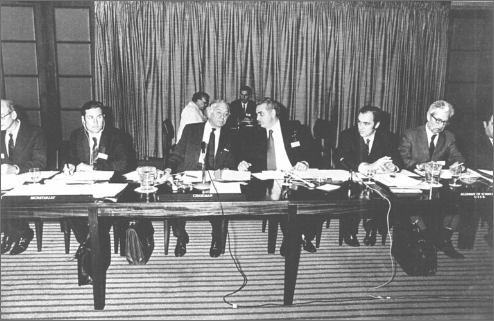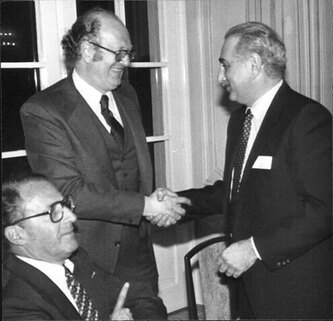A systems analysis legacy spanning 50 years: From Cold War to global warming
IIASA was founded in 1972 to promote East-West scientific cooperation during the Cold War. Today, it builds international and interdisciplinary research teams to identify ways to address the global challenges of the 21st century. Over the last fifty years, IIASA has had significant impact as shown in the timeline of achievements and summarized in the broad areas below.
 Signing the IIASA charter in 1972 © IIASA
Signing the IIASA charter in 1972 © IIASA
Improving policies to tackle national, regional, and global issues
Systems analysis shapes policies that provide long-lasting solutions by taking account of synergies, trade-offs, feedbacks, and emerging phenomena. This approach, for instance, found new and successful ways to manage the spruce budworm pest in Canadian forests in the 1970s, and was instrumental in tackling water pollution in Japan, the USA, and the USSR in the 1980s. IIASA research has helped Europe reduce air pollution since the 1990s and is now being applied across Asia to address the problem. Today, the institute’s work is finding smarter ways to achieve the Sustainable Development Goals, ranging from improving food production and water management in the Indus valley, to finding the most cost-effective ways to limit climate change. Testament to the success of the institute’s methodology is the growing use of systems thinking across governments and international organizations to inform policies.
Advancing the methods and tools of systems analysis
Over the last 50 years, innovations by IIASA researchers have transformed research methods. Nobel Prize winner, Bill Nordhaus, credits IIASA with enabling his early thinking into the economics of climate change in the 1970s. Cooperation between a US demographer and a Soviet mathematician in the 1980s led to the development of more reliable probabilistic population projections, and the IIASA MESSAGE model continually developed since the 1970s, has helped over a hundred countries to better plan their energy systems. In addition, IIASA researchers have helped pioneer scenarios to identify feasible pathways to tackle climate change since 2000. Today, IIASA research expertise attracts between 50 and 100 early career researchers and up to 100 visiting researchers a year to advance their skills in systems analysis.
Building an international network of systems thinkers
In the 1970s and 1980s, IIASA brought together researchers from the countries of North America, the Soviet Union, and Western Europe to work on common problems facing all countries. This was the start of an international network of systems thinkers, facilitated not just by bringing scientists together physically at IIASA, but also through innovative digital infrastructure with the first permanent computer network connections for science and research between the East and West. Nowadays, IIASA brings together researchers from over 60 countries to work at the institute, while developing an even larger network of collaborators that annually include some 2000 coauthors and 680 research partner institutions. Many are members of IIASA Connect, an innovative platform that connects the global systems analysis community.
The founding story
The following edited transcript of a talk Raiffa gave at IIASA on 23 September 1992 describes how it all began.
The IIASA charter was signed in London in October 1972, but the history goes back six years earlier. In 1966 American president Lyndon Johnson gave a rather remarkable speech — in the middle of the Cold War — in which he said it was time that the scientists of the United States and the Soviet Union worked together on problems other than military and space matters, on problems that plagued all advanced societies, like energy, our oceans, the environment, health. And he called for a liaison between the scientists of East and West.
 Howard Raiffa shaking hands with Academician Jermen Gvishiani (IIASA Council Chair from 1972 to 1987) © IIASA
Howard Raiffa shaking hands with Academician Jermen Gvishiani (IIASA Council Chair from 1972 to 1987) © IIASA
Johnson enlisted McGeorge Bundy, former adviser to presidents Kennedy and Johnson, to pursue the topic. One of the first things he did was to commission a report from the Rand Corporation, which was written by Roger Levien, the second director of IIASA. The report gave the United States a green light to go ahead. Bundy also met the late Jermen Gvishiani, the deputy minister of the Soviet State Committee on Science and Technology — and he was delighted with the reaction.
Bundy and Gvishiani realized that if IIASA was going to be stable, it should be multilateral. On that basis, Gvishiani pushed for inclusion of the German Democratic Republic. This was embarrassing for the United States which didn’t recognize East Germany. Our first crisis. It was surmounted by deciding that the new institute would be nongovernmental. How lucky!
What that meant was not very clear because the intention was that governments would finance the center. For the USA it meant that the National Academy of Sciences got into the act. The money went from the National Science Foundation, which is governmental, to the academy, which is nongovernmental.
On a Saturday afternoon early in 1967 I got a call from Bundy at home, saying that he was in Cambridge, Massachusetts, and could he meet me the next day; he would like me to do some consulting. I said, “What kind of consulting?” He said, “It’s pro bono but it won’t take long….”

